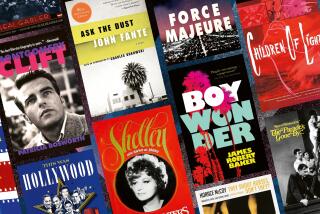Review: ‘70s director Hal Ashby and his wonderful films are captured in the fascinating documentary ‘Hal’
Numerous landmark directors did remarkable work in Hollywood in the 1970s, but a convincing argument can be made that Hal Ashby and his films represented that decade at its best.
As filmmaker Alexander Payne points out in the simply named “Hal,” the lively and evocative documentary on the man, Ashby “directed seven great films in nine years,” including perennial favorites such as “Harold and Maude,” “The Last Detail,” “Shampoo,” “Coming Home,” “Bound for Glory” and “Being There.”
For the record:
11:20 a.m. Sept. 13, 2018An earlier version of this article incorrectly attributed a comment to Rebecca De Mornay. It was said by Rosanna Arquette.
More than that, Ashby’s films, in their integrity and ability to capture genuine emotion on the fly, reflected the spirit of that countercultural age in a way that prefigured today’s American independent movement.
Ashby’s long absence from the scene - he died of pancreatic cancer in 1988 at age 59 - has affected his legacy, something that “Hal” director Amy Scott — like her subject an editor making a feature debut at age 40 — is determined to rectify.
Scott goes about revealing the man, where he came from, why he was so good and why it all went away, working with the cooperation of the director’s estate and making excellent use of on-camera interviews, personal letters and audio recordings Ashby himself made.
“Hal,” which took five years to make, was a passion project for the director. And it apparently struck the same chord for the more than two dozen people she interviewed, everyone from collaborators such as Robert Towne, Jane Fonda and musician Yusuf/Cat Stevens to contemporary admirers such as Payne, Judd Apatow and David O. Russell.
With his long flowing hair and luxuriant beard, Ashby was an American original, an individual who had what a friend calls “a spiritual something about him,” and not just because he smoked a lot of marijuana, which he did.
A zealot for peace and love who had a decidedly quirky sense of humor, a believer in good causes often well before they were popular, Ashby created safe spaces for his collaborators and used his exceptional gifts as an editor to insure that everything came out all right.
“Emotional truth was everything to him,” one of his admirers says, a quality that contributed both to his success and his undoing when the 1970s turned to the 1980s and the studio business executives Ashby despised reasserted their dominance.
By many standards, Ashby was an unlikely candidate for Hollywood fame. He was a high school dropout from Ogden, Utah (his father committed suicide when he was 12) who hitchhiked to Los Angeles and began his studio career as a multilift operator.
Determining that being an editor was the best way to learn the business, Ashby apprenticed with Robert Swink, William Wyler’s editor, and got so good at the craft that he won the editing Oscar for “In the Heat of the Night.”
That award was the result of a random meeting on the Universal lot with a young director named Norman Jewison, who directed “Night” and three other films Ashby edited.
, Tthe two became the closest of friends, and the most moving sequences in “Hal” involve the now 92-year-old Jewison reminiscing about his departed soulmate and reading from letters that often closed with sentiments like “with 18 tons of peace and love.”
Ashby and Jewison set up shop in Frank Sinatra’s former bungalow on the Goldwyn lot in Hollywood, and the habits of a lifetime took shape there: sleeping little, smoking weed (“you could get a contact high just walking in,” a visitor says) and using his phenomenal memory for footage as he worked almost around the clock. (Even though he was married five times and had no lack of female companionship, everyone agrees that the reality was that Ashby was married to his job).
Jewison helped him get his first directing job, 1970’s “The Landlord,” a prescient film about gentrification starring Beau Bridges. It labored under an atrocious ad campaign, the first of the director’s many grievances against the studio system.
“Hal” deals with each of the director’s films in a smart, engaging manner. As befits a former editor, director Scott has an ear for the great quote and the skill to make it all flow beautifully, to both entertain and help us understand who Ashby was and what he wanted to do.
In the 1980s, Ashby’s touch deserted him and Scott does not dwell on the failures, though she does mention that the director was deep into pre-production for “Tootsie” before threats and bickering between studios forced him off the project. In retrospect, it proved to be his last chance.
Though Ashby made many wonderful films, his story is as much a cautionary tale as anything else. “They hurt his spirit, his will,” says actress Rosanna Arquette. “They didn’t respect him and it killed him.”
----
“Hal”
No rating
Running time: 1 hour, 30 minutes
Playing: Landmark’s Nuart, West Los Angeles.
More to Read
Only good movies
Get the Indie Focus newsletter, Mark Olsen's weekly guide to the world of cinema.
You may occasionally receive promotional content from the Los Angeles Times.











